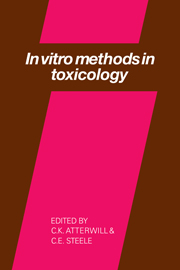In vitro immunotoxicology
Published online by Cambridge University Press: 06 August 2010
Summary
INTRODUCTION
Increasing concern that certain environmental agents may be directly responsible for adverse changes in immune competence has resulted in immunotoxicology becoming established as an important sub-discipline of toxicological studies.
Whilst traditional pathological methods have implicated various lymphoid organs as possible targets for toxic insult, it is only relatively recently that the complexity and far-reaching consequences associated with local and/or systemic immunotoxic interactions have become fully appreciated. This increasing awareness stems in part from recent advances in immunology and molecular biology which have provided new and precise techniques for the detection and evaluation of immune associated toxic lesions. These novel approaches to toxicity study have not only increased our understanding of the regulatory mechanisms which govern the normal functions of the immune system but have also emphasised the importance of the immune system as a sensitive and perhaps early indicator of cellular toxicity.
THE IMMUNE SYSTEM ; STRUCTURE AND FUNCTION
The unique sensitivity of the immune system is without doubt a consequence of its inherent complexity. Analysis of the immune repertoire of man and a variety of experimental animals has revealed the mammalian immune system to be a finely tuned and precisely regulated mechanism involving multiple interactions between numerous subsets of T cells (thymus-matured lymphocytes), B cells (bone marrow-matured lymphocytes) and a variety of antigen processing accessory cells of macrophage origin (Figure 1).
- Type
- Chapter
- Information
- In Vitro Methods in Toxicology , pp. 319 - 336Publisher: Cambridge University PressPrint publication year: 1987
- 2
- Cited by



